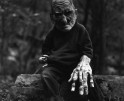Cathy Spence: Crooked Eye
Cathy Spence came to Houston an the FotoFest Reviews with a poignant and personal project, Crooked Eye, that captures the normal life of a boy with oculocutaneous albinism while focusing on the struggles of both albinism and adolescence. The work is painterly, quiet, and sensitive, as a mother’s gaze finds beauty and mystery in the worlds of growing up.
Cathy Spence is a fine art photographer living and working in Beaumont, Texas. She received a Bachelor of Fine Arts degree in 1997 from Lamar University. Cathy has photographs in the Wittliff Collection of Southwestern and Mexican Photography, Museum of Fine Arts Houston, and the Humanities Research Center at the University of Texas in Austin. She was awarded the Houston Center of Photography Fellowship in 1998. Her work has been included in group shows: “Fotofest: New Discoveries,” PDNB Gallery, Dallas, Texas, 1998; “Will Power” Rudolph Poissant Gallery, Houston, Texas, 1998; “Nude,” PDNB Gallery, Dallas, Texas, 1999; “Braun, Francois, Spence, King,” Stephen L. Clark Gallery, Austin, Texas, 2001; and the traveling exhibition “Inside/Outside,” which showcased ten Texas women photographers selected by Anne Tucker, former curator of photography at MFAH. Her solo exhibitions “Saints and Satyrs” appeared at the Art Studio, Beaumont, Texas, 2000; and Stephen L. Clark Gallery, Austin, Texas, 2003.
Crooked Eye
Wesley has a lazy eye he calls his “crooked eye.” Though albinism’s most noticeable characteristics are very pale skin and white hair, Wesley, like others with his condition, is genetically predisposed to have vision problems and often experiences societal pressures related to issues of identity as an adolescent with albinism.
His “crooked eye” is caused by strabismus, a condition where one or both eyes turn either inward or outward, causing a lack of depth perception. But this is only one of a long list of vision problems with which Wesley contends. Pigment in the eyes helps absorb light and cut down on glare. Lacking pigment, people with albinism suffer from photophobia, a sensitivity to light. Involuntary movement of the eyes, the misrouting of optic nerves, and fewer cones and rods needed to define detail also contribute to Wesley’s poor eyesight.
People with albinism often receive negative attention, harassment or, at the least, curious stares and thoughtless comments. Wesley has had thirteen years of dealing with the extra attention. Still, it leaves him feeling a bit like an outsider. Through these ongoing photographs of Wesley not only am I sharing the life of a preteen boy whose appearance sets him apart from friends and family, but also seeking to engage and educate viewers regarding visual impairment issues inherent in albinism.
Instagram: cspence.art
Posts on Lenscratch may not be reproduced without the permission of the Lenscratch staff and the photographer.
Recommended
-
Yorgos Efthymiadis: The James and Audrey Foster Prize 2025 WinnerJanuary 2nd, 2026
-
Time Travelers: Photographs from the Gayle Greenhill Collection at MOMADecember 28th, 2025
-
Jamel Shabazz: Prospect Park: Photographs of a Brooklyn Oasis, 1980 to 2025December 26th, 2025
-
Martin Stranka: All My StrangersDecember 14th, 2025
-
The Family Album of Ralph Eugene Meatyard at the High MuseumDecember 10th, 2025




































































